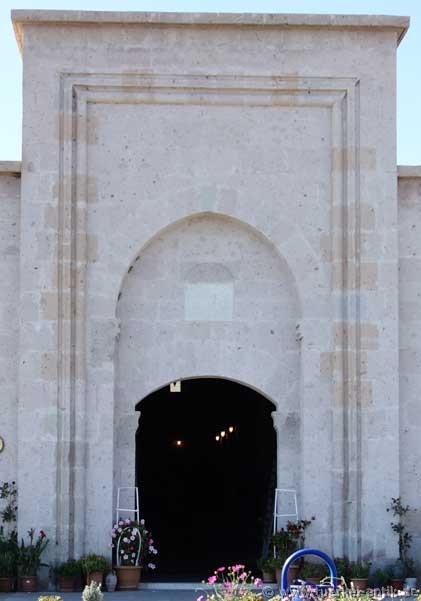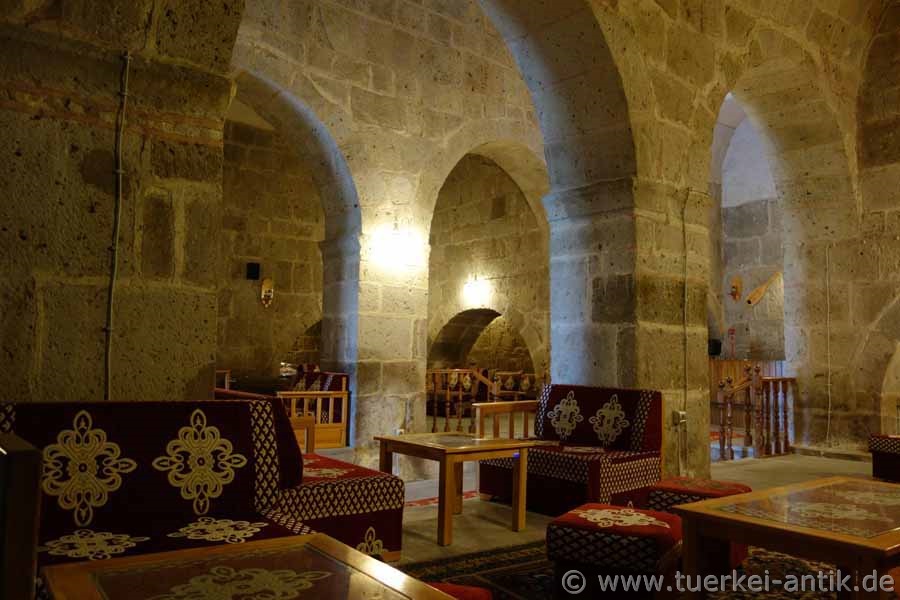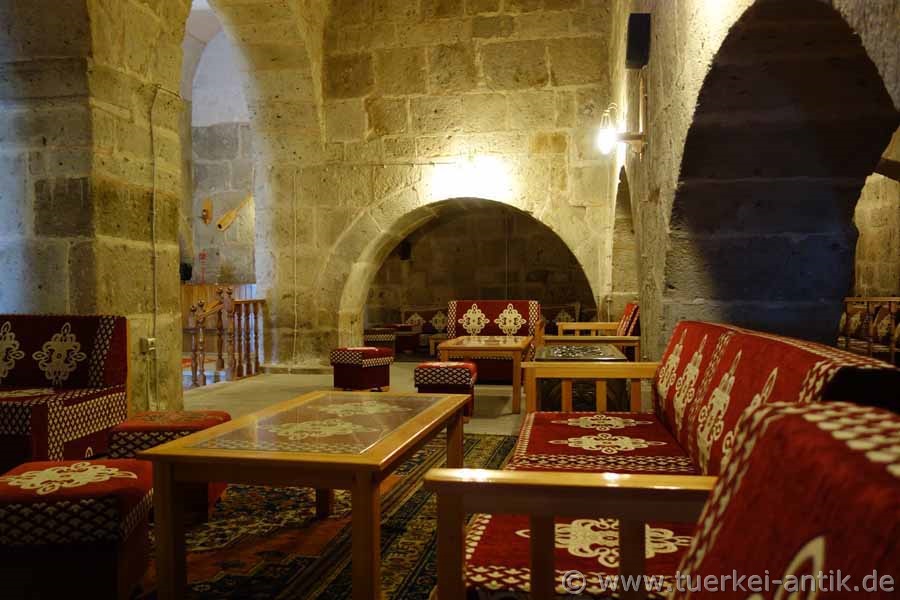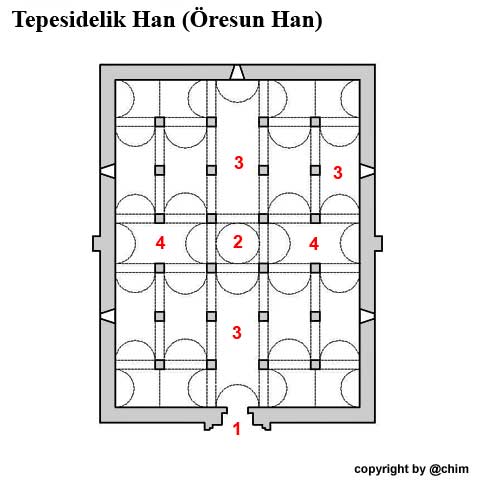 |
| Tepesidelik Han (Íresun Han) | |||||||||||
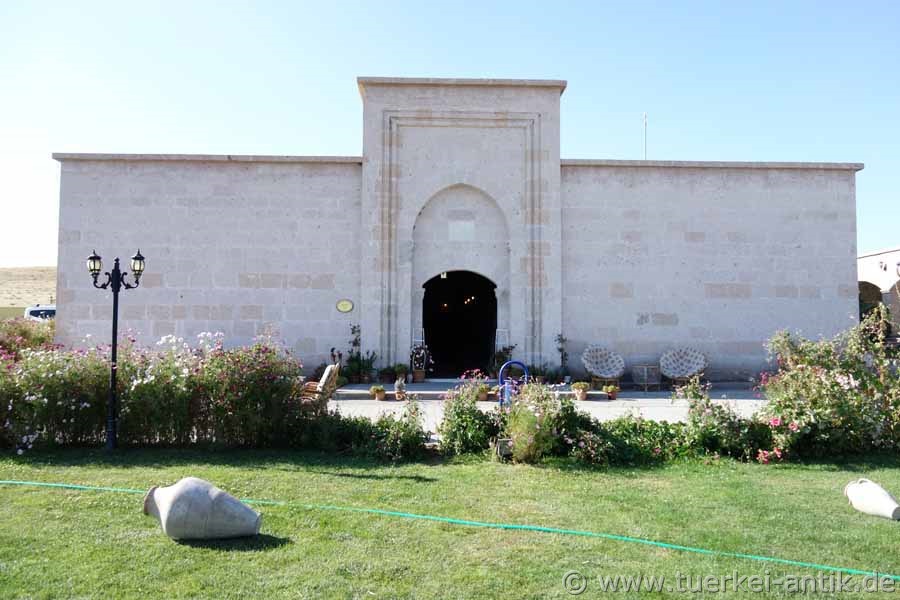 |
|
||||||||||
| The front | |||||||||||
|
The Han is popularly called Tepesi delik Han ("The Han, whose roof has a hole") because of the collapsed roof. Today also Íresun Hani, but also Oresin Hani, Íresin Hani. |
|||||||||||
|
|
|||||||||||
|
The entrance portal |
|||||||||||
|
In 2007, the Konya Regional Directorate decided to renovate the Han. In the same year the inscription plate was found under the ruins, indicating the construction of the Han. The
The English translation of the inscription reads: Malik Sultan Shah, son of Kiliš Arslan, son of the Shah and great Sultan Mas'ud, The plate is now above the portal. The year of construction was set at 1188 (corresponding to 584 of the Islamic calendar) and the second eldest son of Kiliš Arslan II, Malik Shah, was named as the founder. Meanwhile there are doubts about the inscription; the last digit is not clearly legible and there are different translation possibilities of the inscription due to the calligraphy. In general, the reign of Sultan Kiliš Arslan II from 1156 to 1192 is considered today as the period of origin for the Han. The renovation was completed in 2010 and on 17 October 2010 the Han was opened as an inn for tourists. |
|||||||||||
 |
|||||||||||
| The spacious parking lot on the southwest side of the building | |||||||||||
|
The renovation from 2007 to 2010 changed the appearance of the Han. The exterior walls were renewed, thickened and covered with sand-lime brick. The facades were also raised, so that from the outside it looks as if the Han has access in every direction. There was nothing left of the former entrance portal, which was completely renovated. No traces of the typical Seljuk Muqarna decoration were found in the debris. Other decorations were not found either. Instead of a round dome, an octagonal pointed dome similar to a pyramid was added during the restoration. |
|||||||||||
|
|
|||||||||||
|
The Tepesidelik Han, also known as Íresun Han, consists of a built-up rectangle about 25 m wide and 34 m long, which is completely covered. The typical courtyard is missing. From the entrance portal the nave goes to the end of the northeast wall. The nave is about two metres higher than the side aisles. In the middle of Hans the transept runs from east to west. At its intersection there is a dome. The arrangement of the side aisles is unusual for a Seljuk Han: they are accessible from all sides; the barrel vaults are supported by 24 columns (see plan). |
|||||||||||
|
|
|||||||||||
|
The round arches and the vault in the Han are also unusual. While the arches are usually slightly pointed, the Tepesidelik Han has round arches. This is due to the fact that stones from a nearby Byzantine building were used for the construction; there was a Byzantine fortification in Kalebalta (north of the Han). At the back there are spolia with carved rosette crosses from destroyed churches of the 5th to 7th centuries. The walls consisted of two walls, the space between which was filled with mortar and rubble. They were thinner than other Seldschuken-Hans. Five small window slits in the middle of the north wall and two each on the east and west sides provide daylight. The dome, which was no longer originally restored, probably also had windows. |
|||||||||||
|
|
|||||||||||
|
|
|||||||||||
|
|||||||||||
| Photos: @chim, Monika P. | |||||||||||
| Translation aid: www.DeepL.com/Translator | |||||||||||
| Source: Wikipedia and others | |||||||||||
|
|
|||||||||||

